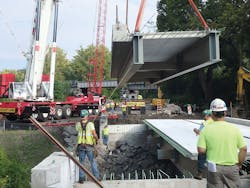Bridge collapses are thankfully rare.
Yet in the face of tragedy, it is a trait perhaps natively human to seek restitution in advance of gathering all facts, to point fingers, and, oftentimes, to shout righteously into the wind. The reader is directed to any comment string or talkback on the web concerning the horrible circumstance of the collapse of the FIU-Sweetwater UniversityCity Bridge over Tamiami Trail on the campus of Florida International University (FIU) on March 15.
At press, what is known is that the 174-ft-long, 32-ft-wide, 950-ton span had just undergone a stress test, after which the cables supporting the deck of the pedestrian bridge were being post-tensioned, presumably to address camber in the precast concrete. Failure began at the north end of the structure and surged quickly toward the center, resulting in full collapse.
In advance of a full investigation by the National Transportation Safety Board, there are nonetheless voices in the digital ether already citing the technique by which the bridge was constructed and placed—known generally as accelerated bridge construction (ABC)—as a potential, if not likely, culprit in the bridge’s failure.
Such an opinion, we discovered, does not wash in the viewpoint of the state department of transportation engineers and professionals who have for years been employing such techniques with the singular purpose of boosting safety.
ABC employed on Pennsylvania S.R. 288 over Wampum Run avoided a 22-mile detour.
Remaining vested
Utah might be considered a wellspring of ABC. To date, the state has successfully completed more than 200 ABC projects within its borders, in both urban and rural locales, with both precast and modulated components. According to the latest FHWA data, a mere 3% of state bridges are considered to be in “poor” condition, a statistic that Utah Department of Transportation (UDOT) Chief Structural Engineer Carmen Swanwick attributes, in part, to its embrace of and engagement with ABC techniques.
“Utah has one of the lowest poor bridge ratings in the country,” Swanwick told Roads & Bridges. “Our ABC program grew due to our capacity projects. We had big design-build projects replacing hundreds of bridges; DBs want to get in and get out, so a lot of innovations came out of those projects that helped advance our ABC program.”
ABC is a relatively broad term, encompassing a great number of techniques—something that the general mass media does not entirely grasp.
“ABC is a very broad term,” Swanwick said, “and really that encompasses a lot of different technology, from prefabricated bridge elements which are built off-site and assembled on-site to bridge slides, which are built adjacent to an old bridge which is then taken down and the new bridge slid into its place with self-propelled modular transporters, much like what was used on [the FIU bridge]. So it’s really a big, broad term.”
While we did not ask any DOT member to speculate on what caused the FIU collapse, those with whom we spoke, including Swanwick, were willing to discuss how ABC is handled in their jurisdictions: “In Utah, we did our first ABC bridge in 2003 and then programmatically instituted ABC in 2007. We now consider it for each project we do. The whole benefit we see, which is one of the major reasons we do it, is that we believe it really does improve safety. Construction workers are not working directly in traffic, and also the time the public is sitting in traffic and driving through construction is minimized. We also believe it improves quality, because you can build off-site in a controlled environment, and the result is a more durable bridge.”
Factors that influence UDOT’s decision to employ ABC include the traffic volume or ADT of a corridor, detour lengths that would be required by traditional construction and environmental constraints such as the proximity of a railroad or nature area.
When asked about the potential impact the FIU collapse might have on UDOT’s position on ABC, Swanwick, expressing remorse and concern for the tragedy itself, was nonetheless adamant in her continued support of the technique:
“We have a lot of processes and procedures in place to assure safety; detailed reviews in both design and construction. We have monitoring plans, contingency plans, and we’ve built a rigorous process to ensure that we get a safe product. We track lessons learned on every project to boost safety and continue learning. I am very confident in our ABC program; we’re going to use it in the future. It’s the way we do business. We believe it to be extremely safe, and we’re going to continue to move in that direction.”
UDOT has a slide-in bridge slated for this July, and four additional projects that may feature full-depth prefab precast decks.
The facts will speak
It wasn’t so long ago that we covered an ABC project in Pottawattamie County, Iowa, where the Little Silver Creek Bridge on Iowa 92 was replaced using modular pre-constructed sections. And while Iowa has, in terms of numbers, a bit less skin in the game than Utah, the Iowa Department of Transportation (IDOT) is nevertheless an active proponent of ABC application.
“While we’ve not done an ABC project as complex as the one at [FIU], we have done several lateral bridge slides and modular component-part projects,” Mitch Dillavou, highway division director for IDOT, told Roads & Bridges. As the lion’s share of land in Iowa leans toward the rural, that has been where IDOT has employed ABC.
“We’ve been doing this for a few years,” Dillavou said, “thus far about 12 projects throughout Iowa on both the county and state system. We don’t speed up the testing or planning; it’s the construction stage that is shorter.”
Projects that have found success in recent years have included the aforementioned Little Silver Creek Bridge; U.S. 6 over Keg Creek; and Iowa 92 in Cass County, where a lateral slide method resulted in a mere 14-day closure. In such instances, speed and safety are both factors and advantages.
“One advantage of ABC is you could take six months to build a bridge in a traditional construction manner,” Ahmad Abu-Hawash, IDOT chief structural engineer, told Roads & Bridges. “With ABC you can construct off-site, then very swiftly slide the structure into place, with a relative minimal impact to the travelling public. The whole point of ABC is to increase safety, not to jeopardize safety. It’s terribly unfortunate to see something like what happened in Florida.”
Despite the tremors radiating through the construction industry as a result of the collapse, Iowa, like Utah, is reserving its judgment—and preserving its faith in ABC.
“With this now in the news, there will be some nervous people,” Abu-Hawash conceded. “Once the NTSB finishes its investigation, I suspect people will go back and say the practice of ABC did not directly cause this. I think initially people will be in shock, but when all the facts come out, I don’t see this as having a long-term effect on ABC. It’s human nature to need to understand what happened. We have ABC bridges in the works now—two in Johnson County and another on Iowa 1 over Camp Creek—and see no need to hit the breaks on them.”
Dillavou agreed, saying, “We’ve certainly talked about doing something as complex [as FIU], and it’s not to say we won’t at some point in the future. We’re waiting to learn from this too.”
Crews working on one of the three spans of the Little Silver Creek Bridge in Pottawattamie, Iowa.
Safety always comes first
Pennsylvania has one of the largest bridge counts in the U.S.—22,779, according to the latest FHWA data. The Pennsylvania Department of Transportation (PennDOT), like all other DOTs, is open to employing those processes that can be made to work to its advantage, and that of course includes ABC.
“We have used accelerated bridge methods in Pennsylvania, and we have not had any issues,” PennDOT Communications Director Rich Kirkpatrick told Roads & Bridges. “However, we have not used the self-propelled mobile transport method [used in FIU]. We have used prefabricated bridge element structures as part of the ABC method. We have 33 bridges completed using [prefab], and eight are scheduled for this year.”
The difficulty in processing what transpired in Florida is the present dearth of information, but Kirkpatrick said that once the reports are in and the facts laid bare, there will hopefully be an opportunity to learn from what went wrong: “We will await findings about the cause of the tragic collapse in Florida and look for any lessons to be learned. We have no way of knowing what specific methods were done in Florida, so it is premature to draw any comparisons. Public safety is PennDOT’s primary concern with every project. [The same] requirements exist on our standard delivery projects as on our accelerated bridge projects.”
One looming question regarding the FIU collapse is whether it is normal, conditional or correct procedure to allow live traffic to flow underneath a structure in the midst of construction. Such a question is natural, notably to the public which likely does not generally pay attention to the fact that such allowances occur on a very regular basis across the country. Nonetheless, Kirkpatrick was adamant that PennDOT has controls in place to mitigate this necessity: “We strictly limit the type of work to be done under live traffic conditions and have stringent tie-down and temporary support requirements. Short-term traffic shutdowns are employed if work needs to be done over a roadway that could affect the structural stability of the bridge. As ABC bridges are being constructed, we have construction inspectors on-site while activities are occurring. So if an ABC project is working 24 hours a day, we have construction inspectors on-site.”
The waiting game
It is difficult to draw any lessons from what has recently occurred—though by the time this writing reaches RB’s readership, much more may be known. As of now it is a game of wait and see, of patience and, according to those with whom we have spoken, perseverance.



